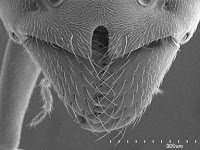Bernasconi et al concluded in their study of European wood ants that their result "represents a clear breakthrough for discriminating between F. lugubris and F. paralugubris and is likely to be helpful in large-scale biomonitoring".
The red wood ants are the dream candidate of the last fifty years for bio-control and monitoring, but they made it never to be actually used. Why do they remain a candidate? May be there is something behind, that they are nevertheless not as good and too complicated and little understand as all the many authors would like to have it. Citing Gösswald 1990 (G¨osswald, K. (1990) Die Waldameise. Band 2: Die Waldameise
in ¨Okosystem Wald, ihr Nutzen und ihre Hege. AULA-Verlag,
Wiesbaden.) seems to be rather ironic and making the point.
This study is also a part of the tradition of European taxonomists and related specialists to claim by solving a local problem to have found the solution to the complex taxonomy, better complex demography of wood ants. First, wood ants are not just lugubris and paralugubris, but include more species. Second, they both have an extensive range with quiet some variation, especially the widely distributed lugubris. Third, there is hybridization observed in several populations.
Why not do what Dlussky already 1967 in this revision of the genus suggested, that the entire populations ought be included? If this genus is so important, a large scale study should be conducted to clean up the mess and produce genetic markers that are based on the entire population of wood ants.
Monday, March 15, 2010
Subscribe to:
Posts (Atom)

